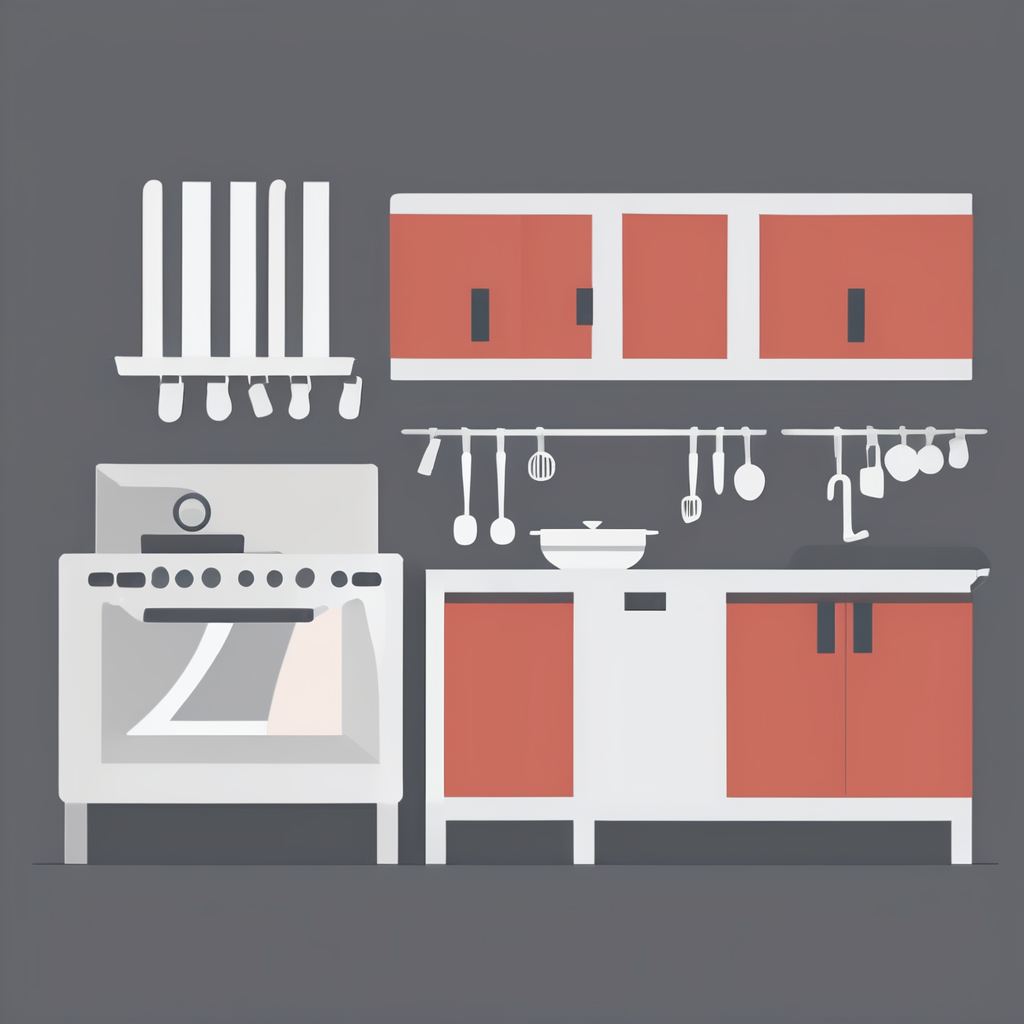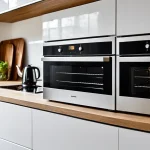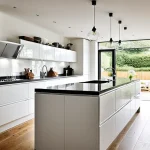Current Innovations Redefining UK Kitchens
The landscape of UK kitchen design trends is rapidly evolving, driven by a blend of aesthetic appeal and functional innovation. Contemporary kitchens increasingly embrace an open-plan layout, facilitating seamless integration with living areas. This shift not only maximizes space but also supports social interaction, making the kitchen a true multitasking hub.
Modern kitchen innovations prominently feature advanced materials such as engineered quartz and textured laminates, which offer durability alongside sophisticated appearances. These materials resist wear and staining, ideal for busy households. Furthermore, smart technology continues to transform kitchen functionality. Voice-activated appliances, app-controlled ovens, and automated lighting enhance convenience and energy efficiency.
Also read : Revolutionizing british kitchens: the impact of cutting-edge technologies
Homeowners now seek remodeling inspiration that balances style with practicality. Integrated storage solutions and customizable cabinetry allow kitchens to adapt to diverse needs, fostering a cleaner, more organized environment. Additionally, eco-friendly choices are integral to current UK kitchen design trends, with energy-efficient appliances and sustainable materials gaining preference.
By embracing these innovations, UK kitchens embody a harmonious blend of beauty, technology, and adaptability, reflecting modern lifestyles without sacrificing comfort or style. Emphasizing multi-functional spaces and smart solutions is key to staying ahead in this vibrant design scene.
Also read : Discover how uk kitchens are embracing renewable energy innovations
The Rise of Smart Kitchens and Technology Integration
Smart kitchen appliances have transformed how we approach cooking and household management. These connected home trends bring convenience and efficiency by linking devices such as smart ovens, refrigerators, and dishwashers to centralized control hubs. This technology integration enables users to monitor and adjust settings remotely, schedule tasks, and receive maintenance alerts, significantly reducing manual effort.
Experts emphasize that the adoption of smart kitchen appliances is accelerating, with more manufacturers embedding sensors and AI into everyday kitchen tools. These advancements allow for personalized cooking experiences, automatic ingredient dispensing, and improved energy management. Such capabilities not only save time but also enhance safety by detecting issues like gas leaks or appliance malfunctions early.
Furthermore, seamless technology integration ensures that all devices communicate effortlessly, creating a harmonious smart ecosystem. For instance, a smart refrigerator can notify a smart oven to preheat based on meal planning, streamlining the cooking process. As the connected home trends evolve, the kitchen is becoming the heart of technologically advanced homes, inviting innovation and smarter living.
Eco-Friendly Materials and Sustainable Design Choices
When designing eco-friendly kitchens, choosing sustainable kitchen materials is key. Popular options include bamboo, reclaimed wood, and recycled metal, all of which reduce environmental impact. Bamboo is fast-growing and renewable, making it ideal for cabinetry and flooring. Reclaimed wood adds character to the kitchen while preventing deforestation. Recycled metals serve well for fixtures and appliances, showcasing innovation in green kitchen design.
Energy-efficient appliances play a significant role in minimizing energy consumption. These devices use less electricity while maintaining high performance and can reduce utility bills over time. Similarly, water-saving fixtures like low-flow faucets and dual-flush toilets significantly cut water usage, aligning with eco-conscious kitchen priorities.
One notable case involves a UK homeowner who replaced conventional materials with low-VOC paints and FSC-certified timber, integrating energy-saving lighting and appliances. This renovation not only lowered their ecological footprint but also improved indoor air quality and comfort. Designs with such materials underscore the practicality and environmental benefits of green kitchen design.
Incorporating these elements ensures your kitchen contributes positively to sustainability goals, making eco-friendly kitchens both functional and future-proof.
Innovative Kitchen Layouts Supporting Modern Lifestyles
Modern homes demand kitchen layout ideas that blend style with practicality. Ergonomic kitchen planning focuses on creating spaces that reduce unnecessary movement, making cooking more enjoyable and efficient. For example, positioning the sink, refrigerator, and stove within a compact triangle minimizes steps, which is a core principle in ergonomic kitchen planning.
Multipurpose spaces are increasingly popular; multifunctional kitchen design includes islands that double as dining tables or workstations. This flexibility supports families juggling meal prep, remote work, and socializing in one area. Storage innovations are crucial too. Smart cabinet organizers, pull-out shelves, and vertical storage maximize space, turning even small kitchens into highly functional areas. Such solutions are essential when adapting to open-plan layouts, where kitchens flow into living and dining rooms, requiring seamless integration without clutter.
For compact urban living, these kitchen layout ideas offer stylish solutions that fit limited square footage without sacrificing utility. Thoughtful designs consider both household needs and entertaining, balancing aesthetics with everyday usability. Embracing multifunctional kitchen design alongside clever storage concepts ensures a kitchen remains the heart of modern living—efficient, adaptable, and welcoming.
Trending Colour Palettes and Aesthetic Choices
Today’s kitchen colour trends in the UK spotlight a move toward soft, muted tones combined with bold accents. Popular palettes often blend deep blues, earthy greens, and charcoal greys with lighter shades such as warm beiges or crisp whites. These combinations support the growing demand for kitchens that feel both contemporary and inviting.
UK kitchen aesthetics frequently embrace textured finishes, pairing matte cabinetry with splashbacks in polished, reflective surfaces. This contrast adds depth while maintaining a sleek, modern style. Layered lighting—incorporating under-cabinet LEDs, pendant lamps, and natural light—enhances these textures and colours, creating dynamic visuals that change throughout the day.
Materials like natural wood, stone, and brushed metal continue to shape modern style kitchens, offering a tactile balance to smooth painted surfaces. Trendsetting UK kitchen projects highlight this trend, showcasing expertly mixed materials that harmonise colour and texture seamlessly.
By combining these elements—thoughtful colour palettes, varied textures, and layered lighting—you can achieve a kitchen aesthetic that feels current, personalised, and functional. This approach answers the desire for kitchens that are not only visually striking but also comfortable to live in.
Enhancing Functionality to Meet Everyday Needs
Functionality in kitchen design focuses on creating an efficient kitchen workflow that simplifies daily tasks. A user-centered kitchen design prioritizes intuitive layouts where everything is within reach, reducing unnecessary steps. This approach enhances kitchen functionality, making meal preparation and cleanup more straightforward.
Innovative storage systems play a key role in boosting ease of use. Pull-out shelves, modular drawer organizers, and vertical storage solutions keep utensils, pots, and pantry items orderly and accessible. These features prevent clutter, saving time and effort during busy routines.
Accessibility is also paramount. Thoughtful designs incorporate adjustable countertops and easily reachable storage to accommodate all family members, including children and those with limited mobility. Family-friendly considerations might include rounded edges on cabinets, soft-close drawers, and distinct zones for cooking, prepping, and cleaning.
By addressing these elements, kitchens become not only more efficient but also comfortable and welcoming spaces for daily life. Prioritizing functionality alongside style ensures the kitchen supports varied activities seamlessly, fostering an environment where users can enjoy cooking and spending time together.
Expert Insights and Real-World Examples
Kitchen designer opinions consistently highlight the growing appeal of contemporary kitchen case studies as practical guides for homeowners. These case studies reveal how sleek lines, minimalist cabinetry, and integrated appliances create efficient, stylish spaces. Industry professionals emphasize functionality without compromising aesthetics, which resonates strongly in today’s UK renovation inspiration.
For example, several UK homeowners have transformed cramped kitchens by adopting open-plan layouts and incorporating clever storage solutions. These real-world examples showcase the blend of smart technology and traditional craftsmanship, a trend many designers foresee continuing. Kitchen designer opinions suggest that choosing durable materials like quartz or engineered wood not only enhances longevity but also fits the modern design ethos.
In addition, experts recommend that homeowners plan their remodels around daily routines to maximize usability. Kitchen designer opinions also encourage exploring innovative lighting techniques to highlight design elements and improve ambiance. Contemporary kitchen case studies underline the importance of thoughtful layout planning, often using islands or breakfast bars to facilitate social interaction.
By studying these real-world UK renovations, homeowners can draw practical inspiration to tailor their own projects. Engaging with contemporary kitchen case studies and expert advice ensures that renovations remain both stylish and functional for years to come.


